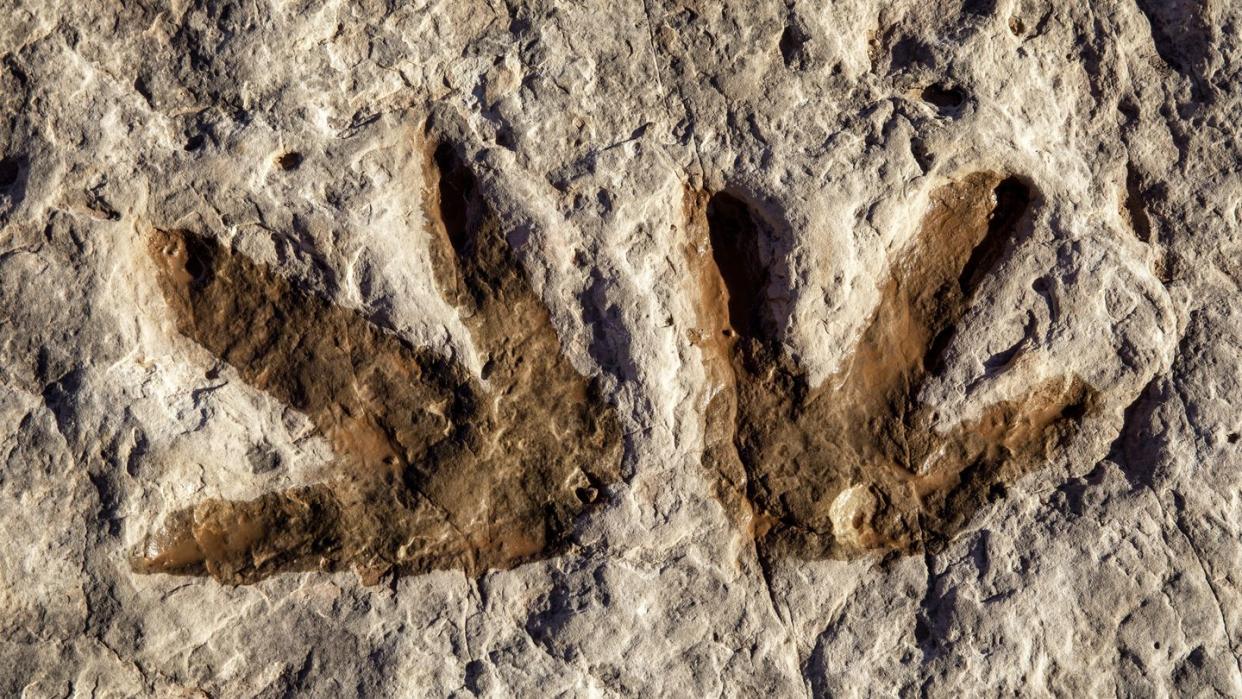Archaeologists Discovered New Dinosaur Footprints—and Mysterious Symbols Next to Them

"Hearst Magazines and Yahoo may earn commission or revenue on some items through these links."
Scientists in Brazil made a remarkable discovery—ancient human petroglyphs along dinosaurs tracks belonging to theropods, sauropods, and ornithopods.
This is an incredibly rare example of an ancient people interacting and possibly understanding the importance of this fossil record.
However, it’s unlikely that these nomadic people knew exactly what created the tracks.
Outside the dreams of some Jurassic Park superfans, humans never lived among dinosaurs (non-avian ones, that is). In fact, the word “dinosaur” only entered our lexicon some 180 years ago, a cool 66 million years after the reign of these misnomered “terrible lizards” met a fiery end. So, while humans and dinosaurs are separated by many geologic epochs, that doesn’t mean ancient peoples didn’t interact with dinosaurs—or, more specifically, the things dinosaurs left behind.
Scientists at Brazil’s National Institute of Historic and Artistic Heritage have discovered human petroglyphs near tracks created by dinosaurs—specifically theropods, sauropods, and ornithopods. The tracks were likely created during the early Cretaceous epoch some 145 to 100 million years ago, whereas the petroglyphs (mostly made up of circles, radial lines, and abstract motifs) were a much more recent creation. They were likely being carved into the rock just 3,000 to 9,000 years ago.
This amazing display of past and (relative) present was found at the Serrote do Letreiro site in Paraíba state in northeastern Brazil—not far from the coastal city of Recife—and was the subject of a new paper published recently in the journal Scientific Reports.
“The petroglyphs represent a unique and significant record, given their direct association with dinosaur fossil tracks,” the paper reads. “This ensemble of archaeological and paleontological evidence unequivocally indicates that human populations during the pre-colonial period interacted with and likely assimilated the fossil record, incorporating such record into their graphical expression, a cultural one, and consequently integrating it into its collective identity.”
Although these petroglyphs seem to indicate an understanding of (or even reverence for) the footprints, it’s likely impossible to know what these symbols represent, or even who made them. The study’s lead author Leonardo Troiano told New Scientist that the peoples who populated northeastern Brazil during this time were “nomadic or semi-sedentary,” and that they “used stone tools and survived by hunting and gathering available natural resources.” In other words, they didn’t leave much behind for archeologists to piece together.
Of course, these ancient peoples couldn’t have known what creatures actually left behind these footprints. And that’s understandable—the common belief in the 18th-century CE was that dinosaur bones belonged to some giant race of extinct humanoids.
According to Troiano, it’s likely that these peoples thought the tracks belonged to some form a giant bird—an assumption that’s actually surprisingly accurate (at least when compared to the bonkers idea of human-like giants). To preserve this paleontological and anthropological wonder, the authors argue for “immediate mitigation measures to prevent further damage” from humans and wild animals.
So, while this site in Brazil isn’t exactly a stroll through a T. Rex paddock on Isla Nublar, it is remarkable evidence that a human-dinosaur relationship of sorts dates back further than we previously believed.
You Might Also Like
